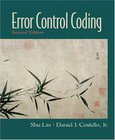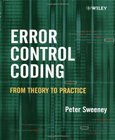Error Control Coding
For B3G/4G Wireless Systems

Book Details:
| Publisher: | Wiley |
| Series: | Wiley |
| Author: | Thierry Lestable |
| Edition: | 1 |
| ISBN-10: | 0470779357 |
| ISBN-13: | 9780470779354 |
| Pages: | 288 |
| Published: | Apr 18 2011 |
| Posted: | Nov 19 2014 |
| Language: | English |
| Book format: | |
| Book size: | 14.48 MB |
Book Description:
Covering the fast evolving area of advanced coding, Error Control Coding for B3G/4G Wireless Systems targets IMT-Advanced systems to present the latest findings and implementation solutions. The book begins by detailing the fundamentals of advanced coding techniques such as Coding, Decoding, Design, and Optimization. It provides not only state-of-the-art research findings in 3D Turbo-codes, non-binary LDPC Codes, Fountain, and Raptor codes, but also insights into their real-world implementation by examining hardware architecture solutions, for example VLSI complexity, FPGA, and ASIC. Furthermore, special attention is paid to Incremental redundancy techniques, which constitute a key feature of Wireless Systems.A promising application of these advanced coding techniques, the Turbo-principle (also known as iterative processing), is illustrated through an in-depth discussion of Turbo-MIMO, Turbo-Equalization, and Turbo-Interleaving techniques. Finally, the book presents the status of major standardization activities currently implementing such techniques, with special interest in 3GPP UMTS, LTE, WiMAX, IEEE 802.11n, DVB-RCS, DVB-S2, and IEEE 802.22. As a result, the book coherently brings together academic and industry vision by providing readers with a uniquely comprehensive view of the whole topic, whilst also giving an understanding of leading-edge techniques.Includes detailed coverage of coding, decoding, design, and optimization approaches for advanced codes Provides up to date research findings from both highly reputed academics and industry standpoints Presents the latest status of standardization activities for Wireless Systems related to advanced coding Describes real-world implementation aspects by giving insights into architecture solutions for both LDPC and Turbo-codes Examines the most advanced and promising concepts of turbo-processing applications: Turbo-MIMO, Turbo-Equalization, Turbo-Interleaving
Download Link:
Related Books:
Error Control Coding
2nd Edition
A reorganized and comprehensive major revision of a classic book, this edition provides a bridge between introductory digital communications and more advanced treatment of information theory. Completely updated to cover the latest developments, it presents state-of-the-art error control techniques. Coverage of the fundamentals of coding and the applications of codes to the design of real error control systems. Contains the most recent developments of coded modulation, trellises for codes, soft-decision decoding algorithms, turbo coding for reliable data transmission and other areas. There are two new chapters on Reed-Solomon codes and concatenated cod...
Error Control Coding
Fundamentals and Applications
Error Control Coding
From Theory to Practice
Error-controlled coding techniques are used to detect and/or correct errors that occur in the message transmission in a digital communications system. Wireless personal channels used by mobile communications systems and storage systems for digital multimedia data all require the implementation of error control coding methods. Demonstrating the role of coding in communication and data storage system design, this text illustrates the correct use of codes and the selection of the right code parameters. Relevant decoding techniques and their implementation are discussed in detail. Providing communication systems engineers and students with guidance in the application of error-control coding, this book emphasizes the fundamental concepts of coding theory ...
Essentials of Error-Control Coding
Rapid advances in electronic and optical technology have enabled the implementation of powerful error-control codes, which are now used in almost the entire range of information systems with close to optimal performance. These codes and decoding methods are required for the detection and correction of the errors and erasures which inevitably occur in digital information during transmission, storage and processing because of noise, interference and other imperfections.Error-control coding is a complex, novel and unfamiliar area, not yet widely understood and appreciated. This book sets out to provide a clear description of the essentials of the subject, with comprehensive and up-to-date coverage of the most useful codes and their decoding algorithms. ...
2007 - 2021 © eBooks-IT.org




